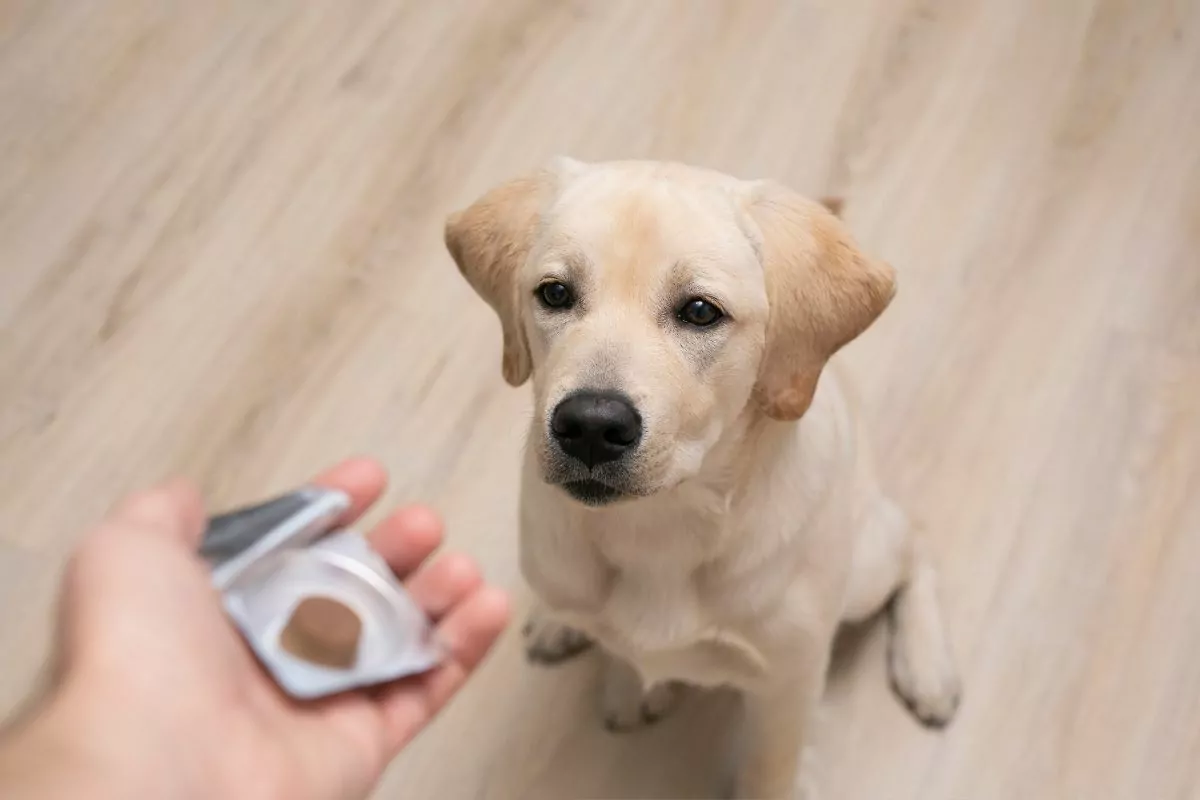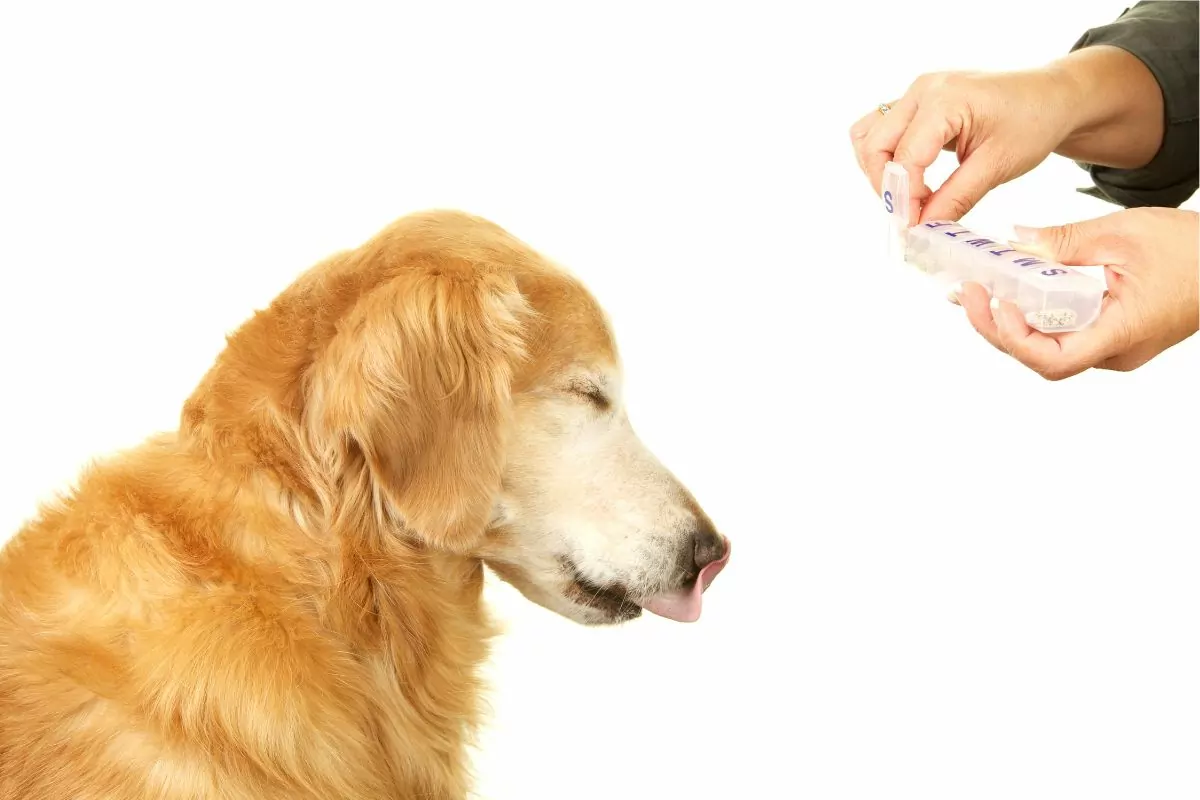What is Sucralfate for Dogs?
Sucralfate for dogs is also known as a gastroprotection medication. It does that: by protecting the gastrointestinal tract from ulcers, and if you have ever had an ulcer, you know just how painful they can be!
But it doesn’t just protect the stomach; Sucralfate helps treat ulcers within the mouth, esophagus, stomach, and even the small intestines!
But are there any possible side effects of Sucralfate in dogs or anything else you should know? Keep reading to find out!

What is Sucralfate Used for in Dogs?
Sucralfate is available under the brand names Antepsin, Carafate, and Sulcrate, among many others. It helps prevent and treat ulcers within the stomach and other areas of the gastrointestinal tract.
Sucralfate was first introduced as a gastroprotection medication in the 1960s for humans: Later, it was FDA approved in the USA in the 1980s. It is a frequent choice of doctors to this day when treating upper small intestinal ulcers in humans – as well as ulcers elsewhere in humans.
Sucralfate for dogs and cats is an “off-label” or “extra-label” medication, meaning it was not a veterinary product originally. However, prescriptions for human medicines in animals are entirely regular. It just means it is essential that you follow your veterinarian’s instructions when using this medication – rather than relying on the information on and in the packaging.
For dogs, the primary intended effect of Sucralfate is to prevent medicinal-induced ulcers, like when a dog receives NSAIDs (a type of painkillers) for long periods.
It can, however, also help treat ulcers already there due to increased acidity in the stomach, as it alleviates the symptoms of the ulcers – allowing for easier administration of other medications.
But Sucralfate for dogs isn’t just for the ulcers that occur due to medication. It can also be useful as part of a holistic plan to treat ulcers that have appeared for other reasons, for example, gastric reflux. The protective coating will help all the way from the mouth to the stomach and the upper small intestines (the duodenum).
Some of the most common symptoms of stomach ulcers in dogs include:
- Lack of appetite.
- Vomiting.
- Abdominal pain.
- Bloody stool.
- Excessive drooling.
- Lethargy (tiredness).
If your dog is experiencing any of the above symptoms, or you know it receives NSAID painkillers, your dog may benefit from receiving Sucralfate. In that case, you should talk to your veterinarian for guidance!
Sucralfate for Dogs – Side Effects
Side effects of Sucralfate in dogs are exceedingly rare, mainly as its primary purpose is to stay within the intestinal tract until excretion of the leftovers through the feces. As it does not reach the bloodstream and other internal body parts, side effects struggle to occur.
In humans, some individuals reported suffering from constipation after receiving Sucralfate, and there are reports of allergic reactions – although these are very rare.
Sucralfate can, however, interact with other types of medication as it decreases the absorption rate of these. Therefore, it is important to separate the administration of Sucralfate and other kinds of drugs.
You must also inform your veterinarian if your dog receives any other types of medication, vitamins, or supplements.
Lastly, Sucralfate works best when the stomach has an acidic environment; therefore, you should ensure that your dog gets Sucralfate tablets at least 30 minutes before receiving antacid medications (e.g., Omeprazole) it may also be receiving. These types of medication are prescribed frequently alongside Sucralfate as they assist in treating ulcers as well.
Sucralfate overdoses are also rarely a worry. If your dog is experiencing untoward reactions after treatment with Sucralfate, you should immediately contact your veterinary care provider.

How to Give Sucralfate for Dogs
Sucralfate for dogs is available as either a tablet or a liquid suspension. You can, however, also turn the pills into your liquid suspension if necessary. A Sucralfate tablet or suspension should be given to the dog by mouth.
The medication must be given on an empty stomach, as food will otherwise prevent the medication from protecting the gastrointestinal tract.
Sucralfate tablets for dogs have no flavor additives, which is unnecessary for humans. It is unlikely that your dog will want to drink or eat the tablet voluntarily; therefore, you may have to inject the solution into your dog’s mouth or hold its mouth to ensure it swallows the pill.
Remember to be careful when doing so, ensuring that you do not inject the solution down the airways, as this will cause your dog to gag and possibly even risk choking!
How to Make a Sucralfate Slurry for Dogs
It is common to prescribe Sucralfate for dogs as a tablet, but many dogs hate swallowing pills – and we can’t blame them once you see the size of a Sucralfate tablet!
To make it all a lot easier for you and your four-legged friend, you can turn the Sucralfate tablet for dogs into a Sucralfate slurry!
Place the tablet in a container and fill it with tap water. Seal the container and carefully shake it until the Sucralfate tablet has dissolved. Ensure you don’t use too much water, as your dog will struggle to swallow it.
Be especially careful if your dog isn’t willing to drink the solution on its own. Give your dog plenty of time to swallow a mouthful before injecting the rest of it into the mouth.
How Does Sucralfate Work in Canines?
Sucralfate activates once it reaches an acidic environment within the gastrointestinal tract. Here it will adhere to the proteins in ulcers and thereby create a protective layer on top of the damaged intestinal lining. Many also describe it as “placing a band-aid” on the ulcer, preventing the dog from experiencing pain when food passes by the ulcers. Read our article and find out the Pain Symptoms in Dogs and Cats.
The Sucralfate for dogs dosage depends on your dog’s size and condition, but most dogs receive ½ to 1 tablet of Sucralfate two to four times a day. Your veterinarian can determine your dog’s optimal dose and unique needs.
How Long Does Sucralfate Take to Work?
The medication should take effect within one to two hours, but the effect may not be visible to you immediately. The ulcers will not disappear, the layer of Sucralfate will provide protection, and it will likely take even your dog some time to notice that.
Can I Dissolve Sucralfate in Water?
If you are making a Sucralfate slurry, you can dissolve the Sucralfate tablet in small quantities of water. It is not advisable to dissolve the tablet in larger amounts, like in the water bowl, etc. The tablet has no pleasant flavor, and the dog is unlikely to want to drink it.
What Does Sucralfate Cost?
The Sucralfate cost range can vary between different regions, nationally and internationally, but, as a rule, Sucralfate is a cheap medication. Most commonly, the cost of a single dose is unlikely to exceed $1. Please note that this may vary, though, for many different reasons.
Can You Crush Sucralfate for Dogs?
You can crush sucralfate tablets, or it can happen if your dog is willing to do so when eating the pill. It does not need to be swallowed whole. However, the tablet should not be crushed and mixed with food as the stomach needs to empty when administering Sucralfate. Mixing with food can inhibit the effect of the medication.
How Long Can My Dog Take Sulcralfate?
Sucralfate for dogs is indicated for short-term use, meaning up to eight weeks. The treatment length can be adjusted and extended if necessary, but it is necessary to consult a veterinarian before doing so.

Our Final Verdict
Sucralfate tablets are an excellent addition to the veterinary world as it allows veterinarians to protect and limit the symptoms dogs with ulcers may be experiencing by coating the irritated and painful area. As it is also a very safe and reliable drug, owners can administer it at home, helping their best friend stay happy and healthy!
